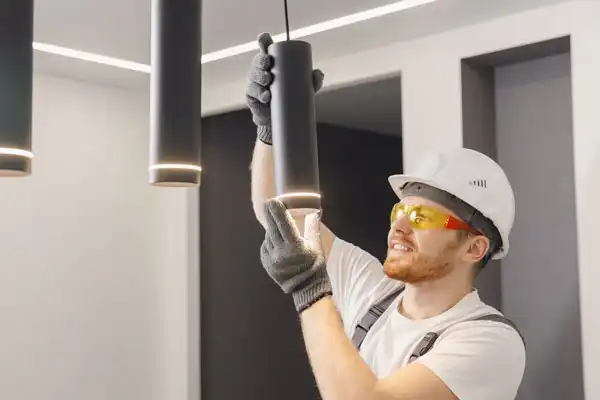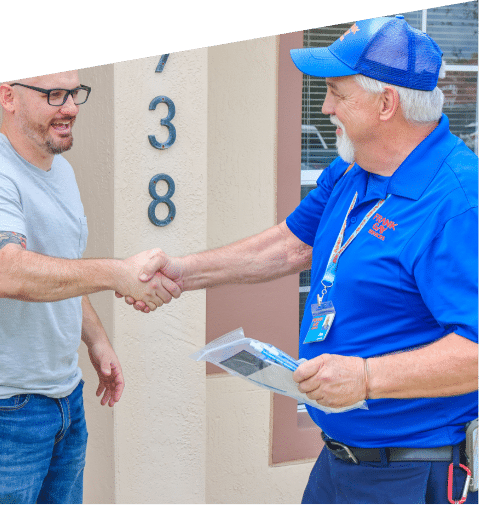Introduction
Living in Florida presents unique challenges for maintaining healthy indoor air quality. Our warm, humid climate creates the perfect environment for mold, bacteria, and other airborne contaminants to thrive in our homes. That’s where UV lighting technology in HVAC systems comes into play.
UV light installation in your home’s HVAC system acts as a powerful defense against these unwanted visitors. This innovative solution works around the clock to:
- Eliminate harmful microorganisms
- Reduce allergens and irritants
- Prevent mold growth in your air conditioning system
- Maintain cleaner, healthier air throughout your home
Florida homeowners can benefit significantly from this technology, as it addresses many common air quality concerns specific to our region. By incorporating UV lights into your HVAC system, you’re not just improving the air you breathe – you’re investing in a more efficient home cooling system that requires less maintenance and operates at peak performance.
The impact is clear: cleaner air, lower energy bills, and a healthier living space for you and your family.
Understanding UV Light and Its Role in HVAC Systems
UV light exists in three distinct forms, each with unique properties and applications:
- UVA (315-400nm): The most common form, present in sunlight
- UVB (280-315nm): Responsible for sunburns and vitamin D production
- UVC (200-280nm): The powerhouse behind HVAC air purification
How UVC Light Works
UVC light stands out as nature’s disinfectant. At a wavelength of 254 nanometers, UVC radiation disrupts the DNA structure of microorganisms, rendering them unable to reproduce or survive. This process effectively neutralizes:
- Bacteria and viruses
- Mold spores
- Other harmful pathogens
The Role of UVC Lights in HVAC Systems
In HVAC systems, UVC lights create a protective barrier against contaminants. Strategic placement near cooling coils and within ductwork maximizes their effectiveness. The lights work continuously to:
- Prevent biofilm formation on cooling coils
- Reduce microbial growth in air handlers
- Sanitize moving air throughout the system
Benefits of UVC Technology in HVAC Systems
The targeted approach of UVC technology delivers significant benefits:
System Performance
- Cleaner coils transfer heat more efficiently
- Reduced maintenance requirements
- Extended equipment lifespan
Air Quality
- Decreased airborne pathogens
- Lower concentration of allergens
- Reduced risk of respiratory issues
The integration of UV technology transforms your HVAC system into a powerful air purification tool. By maintaining clean coils and ductwork, UV lights ensure the air circulating through your Florida home stays fresh and healthy while your system operates at peak efficiency.
Installing UV Lights in Your HVAC System: What You Need to Know
Strategic placement of UV lights in your HVAC system plays a crucial role in maximizing their effectiveness. Let’s explore the key installation locations and professional requirements for optimal performance.
Primary Installation Locations:
- Coil-mounted UV lights: Positioned directly above the indoor cooling coil to prevent mold and bacteria growth
- Air-sanitizing UV lights: Installed in the return air duct to treat moving air
- Dual-lamp systems: Combined installation in both locations for comprehensive coverage
Professional Installation Requirements:
- Safety considerations
- Proper electrical connections
- Protective shields to prevent UV exposure
- Correct mounting angles for maximum effectiveness
- Technical expertise needed
- System compatibility assessment
- Airflow pattern analysis
- Power supply requirements
- Safety sensor installation
A professional HVAC technician will determine the ideal placement based on your system’s configuration and air treatment needs. They’ll consider factors such as:
- Air handler size and layout
- Ductwork configuration
- System airflow patterns
- Available mounting space
- Power source accessibility
Safety Considerations
UV light exposure can be harmful to eyes and skin. Professional installation ensures proper shielding and safety mechanisms are in place. Technicians use specialized tools and protective equipment to handle UV lamps safely during installation and maintenance procedures.
The installation process requires precise measurements and careful handling of components. Your HVAC professional will also install warning labels and safety indicators to alert homeowners and maintenance personnel about the presence of UV light in the system.
Evaluating the Benefits and Drawbacks of UV Lights for Your HVAC System
UV light technology offers significant advantages for your HVAC system, yet it’s essential to understand both its strengths and limitations. Let’s examine the key benefits and potential drawbacks:
Notable Benefits:
- Eliminates up to 99.9% of airborne bacteria and viruses
- Reduces mold spores and other biological contaminants
- Decreases unpleasant odors caused by microbial growth
- Helps prevent “sick building syndrome” symptoms
Impact on Respiratory Health:
- Reduces common asthma triggers
- Minimizes allergic reactions to indoor pollutants
- Creates a healthier breathing environment for sensitive individuals
- Supports better sleep quality through cleaner air
Potential Limitations:
- UV lights don’t filter dust, pet dander, or other particulate matter
- Some microorganisms may require longer exposure time for elimination
- Effectiveness varies based on:
- Air flow speed through the system
- Distance between UV lamp and target areas
- Humidity levels in the environment
Additional Considerations:
- UV lights work best when combined with traditional air filters
- Regular maintenance ensures optimal performance
- Initial investment costs may be higher compared to basic filtration
- Replacement bulbs needed every 12-24 months
For maximum air quality improvement, UV lights should be part of a comprehensive air purification strategy that includes proper filtration and regular system maintenance.
Determining If a UV Light is Right for Your Home’s HVAC System
Deciding to install UV lights in your HVAC system requires careful consideration of your home’s specific needs. A professional air quality assessment can help identify existing issues and determine if UV light technology is the right solution for your situation.
Key factors that suggest UV lights might benefit your home:
- Persistent musty odors or visible mold growth
- Family members with allergies, asthma, or respiratory sensitivities
- High humidity levels in your home
- Recent water damage or flooding
- Frequent AC coil cleaning requirements
- Dark or poorly ventilated spaces
Signs your home might need a professional evaluation:
- Unexplained respiratory symptoms that improve when away from home
- Increased allergy symptoms during AC operation
- Higher than normal energy bills
- Frequent HVAC maintenance needs
A qualified HVAC technician can perform a comprehensive home evaluation to:
- Measure current indoor air quality levels
- Inspect your HVAC system’s condition
- Identify potential contamination sources
- Assess your home’s ventilation patterns
- Recommend appropriate UV light placement
The results of this evaluation will help determine if UV light installation would provide meaningful benefits for your specific situation. Your HVAC professional can also suggest complementary solutions that work alongside UV technology to create the healthiest possible indoor environment.
The Importance of Professional Installation and Maintenance for Optimal Performance
Professional installation and regular maintenance checks are essential for a successful UV light HVAC system. Here’s why they matter:
Why Professional Installation is Important
A certified technician brings specialized knowledge to ensure your UV system is set up correctly:
- Optimal Lamp Positioning: UV lamps need to be positioned at specific angles to achieve maximum exposure. This is crucial for effective air purification.
- Safety Mechanisms: Installing safety mechanisms is vital to prevent accidental UV exposure, ensuring the safety of occupants and maintenance personnel.
- Electrical Connections and System Integration: Proper electrical connections and integration with the HVAC system are critical for seamless operation.
- Lamp Intensity and Coverage Verification: The technician will verify that the lamp intensity meets specifications and that the coverage area is sufficient for your space.
Why Regular Maintenance is Necessary
Your UV system requires specific ongoing maintenance tasks to maintain peak performance:
Regular Inspections
These inspections should be conducted periodically to identify any potential issues:
- Lamp Intensity Levels: Checking the intensity levels of the UV lamps ensures they are functioning optimally.
- Safety Switches and Controls: Testing safety switches and controls verifies that the safety mechanisms are working properly.
- Mounting Hardware and Connections: Examining the mounting hardware and connections ensures they are secure and intact.
- Ductwork Inspection: Inspecting the ductwork for any UV-related degradation helps identify any damage caused by prolonged UV exposure.
Scheduled Maintenance
In addition to regular inspections, scheduled maintenance tasks should also be performed:
- UV Lamp Replacement: Replacing UV lamps before they lose effectiveness (typically every 12-24 months) ensures continuous air purification.
- Lamp Surface Cleaning: Cleaning lamp surfaces to remove dust or debris allows for maximum light output.
- Lamp Position Adjustment: Adjusting lamp positions as needed ensures optimal exposure of the airflow.
- Safety Component Updates: Updating safety components as per manufacturer recommendations ensures ongoing protection.
Monitoring System Performance Metrics
Professional technicians also monitor system performance metrics to catch potential issues early. They track:
- Air quality measurements
- Energy consumption patterns
- System runtime efficiency
- Component wear indicators
A properly maintained UV light system operates at maximum efficiency, providing consistent air purification while protecting your HVAC investment. Professional service visits help prevent system failures and ensure your indoor air quality remains at optimal levels year-round.
Conclusion: Embracing UV Lighting Technology for a Healthier Home Environment
UV lighting technology transforms your HVAC system into a powerful defender of your home’s air quality. The benefits speak for themselves:
- Cleaner, Healthier Air – Elimination of up to 99.9% of harmful pathogens
- Enhanced System Performance – Improved energy efficiency and extended equipment life
- Peace of Mind – Continuous protection against airborne contaminants
Your home deserves the best protection available. A professional HVAC expert can evaluate your specific needs and recommend the ideal UV light solution for your system. Take the first step toward creating a healthier living environment – contact a qualified HVAC technician to discuss how UV lighting can safeguard your home’s air quality today.
FAQs (Frequently Asked Questions)
What is UV lighting and how does it work in HVAC systems?What are the benefits of installing UV lights in my HVAC system?Where should UV lights be installed in an HVAC system?Do I need professional installation for UV lights in my HVAC system?Are there any drawbacks to using UV lights in my HVAC system?How can I determine if a UV light is right for my home’s HVAC system?
To determine if a UV light is necessary for your HVAC system, consider assessing your existing air quality issues. Consulting with HVAC professionals can provide tailored solutions based on your specific needs and circumstances.



